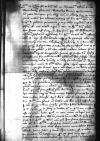List #1577
[Ioannes DANTISCUS] do [Mauritius FERBER]Cracow (Kraków), 153[7]-02-02
Rękopiśmienne podstawy źródłowe:
Pomocnicze podstawy źródłowe:
Publikacje:
| ||||||||||||
Tekst + aparat krytyczny + komentarz Zwykły tekst Tekst + komentarz Tekst + aparat krytyczny Ekscerpty dotyczące podróży Dantyszka
Reverendissime in Christo Pater et Domine, Domine mi observandissime. Salutem et mei commendationem plurimam.
Nactus huius nuntii oportunitatem non potui committere, quin, antequam meum, ut pollicitus sum in cf.
De gravaminibus et maxime de articulis
Nova hic prorsus nulla. Cras
Fertur
Ex
[1 ] The Prussian gentry’s legation presented the king with gravamina containing about 20 objections, mainly against the Prussian Council and against the domination of the great cities (especially Gdańsk) over the region. The gravamina concerned economic matters (taxes, commerce, customs duty, measures and weights, minting of coins), legal issues (court procedure, court fine amounts, interpretation of the law on indigenousness, codification of Chełmno law, attacks by noblemen from neighboring voivodeships, accusations against Johann von Werden), administrative matters (the procedure of convoking general and particular assemblies, marking of territorial borders in Prussia), and defense (vetting) (print: cf. Gottfried Lengnich, Geschichte der Preussischen Lande Königlich-Polnischen Antheils Seit dem Jahr 1526, Biss auf den Todt Königes Sigismundi I, vol. 1, Dantzig, Johann Daniel Stollen, 1722 ⌊LENGNICHcf. Gottfried Lengnich, Geschichte der Preussischen Lande Königlich-Polnischen Antheils Seit dem Jahr 1526, Biss auf den Todt Königes Sigismundi I, vol. 1, Dantzig, Johann Daniel Stollen, 1722 ⌋, doc. No. 73, p. 173-183)
[2 ] Paweł Płotowski strove to obtain the succession to the Warmia bishopric from Maurycy Ferber
[3 ] The Royal Prussian gentry’s legation to the 1536/37 Diet was accompanied to Cracow by Ermland canons
[4 ] The Prussian Council legation’s written opinion on the gentry’s gravamina, presented to the king, contained detailed responses to all the problems listed by the gentry’s envoys. The text of this opinion was published by Lengnich (cf. Gottfried Lengnich, Geschichte der Preussischen Lande Königlich-Polnischen Antheils Seit dem Jahr 1526, Biss auf den Todt Königes Sigismundi I, vol. 1, Dantzig, Johann Daniel Stollen, 1722 ⌊LENGNICHcf. Gottfried Lengnich, Geschichte der Preussischen Lande Königlich-Polnischen Antheils Seit dem Jahr 1526, Biss auf den Todt Königes Sigismundi I, vol. 1, Dantzig, Johann Daniel Stollen, 1722 ⌋, doc. No. 74, p. 183-190.)
[5 ] Sigismund II Augustus’ swearing-in took place not the next day, as Dantiscus expected, but the day after that – February 4, 1537 (cf. cf.
[6 ] During the Diet, in December
1536, papal nuntio Pamphilus de Strassoldo was in Cracow. Pamphilus de Strassoldo as the papal nuntio was present at the Cracow Diet from November 18 to ca. December 15, 1536. One of his main tasks was to give the bishops the papal bullae and brevia convening a General Church Council. One of the main aims of his mission was to deliver papal bullae and brevia convening a General Church Council to the archbishops of Lvov, Gniezno and Riga. The archbishops were meant to give these documents to the bishops, chapters and monastic congregations in their archdioceses. Dantiscus is doubtless referring to these documents (cf.cf. Acta Nuntiaturae Polonae tomus 2: Zacharias Ferreri (1519-1521) et nuntii minores (1522-1553), ed. by Henryk Damian Wojtyska, Friburgi Helvetiae, Institutum Historicum Polonicum Romae, 1992, series ed.(s): Henryk Damian Wojtyska ⌊ANPcf. Acta Nuntiaturae Polonae tomus 2: Zacharias Ferreri (1519-1521) et nuntii minores (1522-1553), ed. by Henryk Damian Wojtyska, Friburgi Helvetiae, Institutum Historicum Polonicum Romae, 1992, series ed.(s): Henryk Damian Wojtyska ⌋, p. 295) (see also cf.

